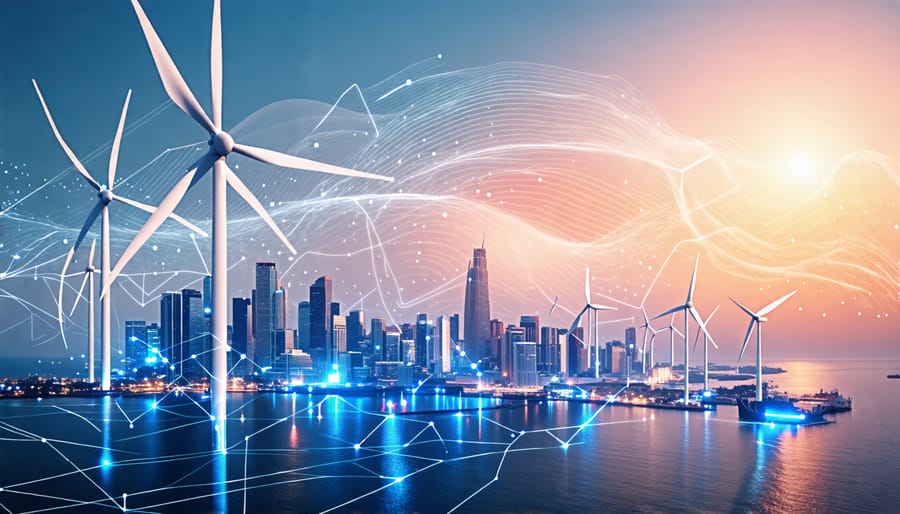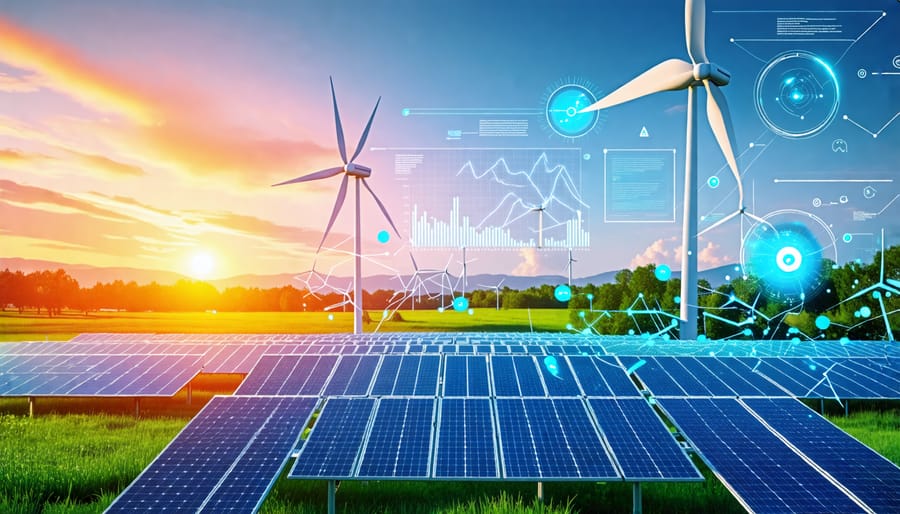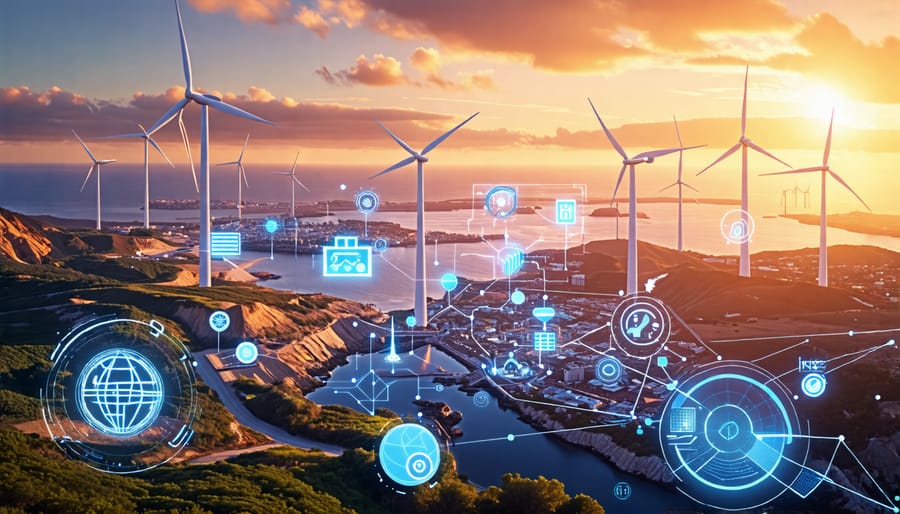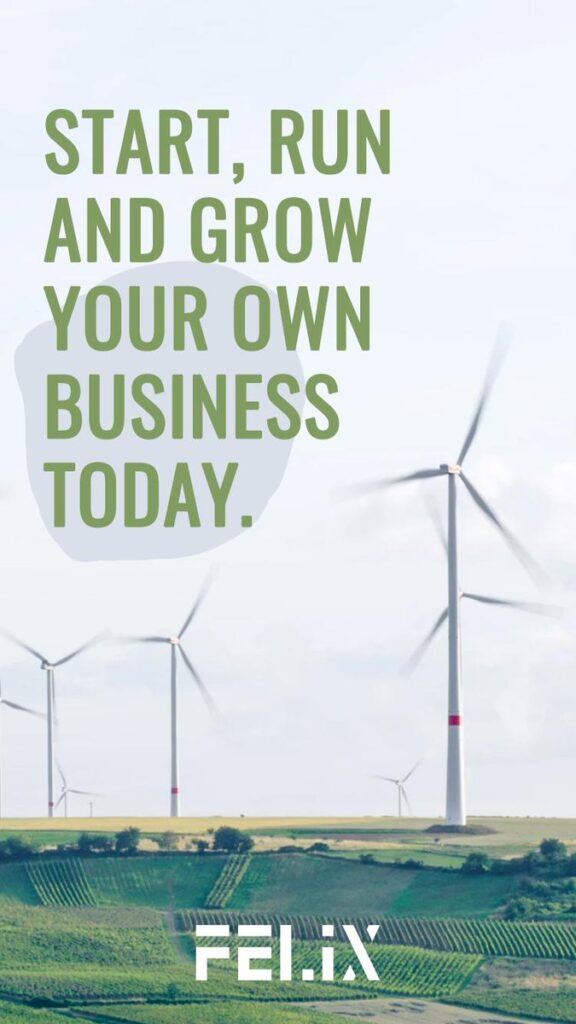Explore cutting-edge wind energy innovations by adopting efficient vertical-axis wind turbines that optimize urban space and minimize noise pollution. Investigate the integration of AI-based predictive maintenance systems to enhance turbine longevity and operational efficiency. Leverage advanced blade materials such as carbon fiber composites to boost durability and performance in varying wind conditions. Collaborate with emerging floating wind farm projects to harness offshore wind resources, elevating energy capacity in coastal regions.
Breakthrough Technologies in Wind Energy
Floating Wind Farms
Floating wind farms represent a groundbreaking innovation in the realm of wind energy, unlocking the potential to harness powerful winds over deep waters where traditional fixed structures are not feasible. Unlike conventional offshore wind farms, which are anchored to the seabed, floating wind turbines are mounted on buoyant platforms. This flexibility allows them to be strategically positioned in areas far from shore, tapping into stronger and more consistent wind patterns.
These pioneering structures have already begun to demonstrate their potential in places like the North Sea and the coast of Japan, regions characterized by deep waters and high wind speeds. By deploying floating wind farms, countries can significantly expand their renewable energy capacity without competing for valuable land space or disrupting coastal ecosystems. This approach offers a sustainable pathway to meet increasing energy demands while reducing reliance on fossil fuels.
In addition to their environmental benefits, floating wind farms bring economic opportunities by fostering innovation in engineering and the development of specialized materials, which can drive job creation and stimulate local economies. As technological advances continue to reduce costs and improve efficiency, the widespread adoption of floating wind farms could revolutionize the renewable energy landscape, making clean power accessible to more regions across the globe. With ongoing research and investment, floating wind technology holds immense promise for shaping a sustainable energy future.
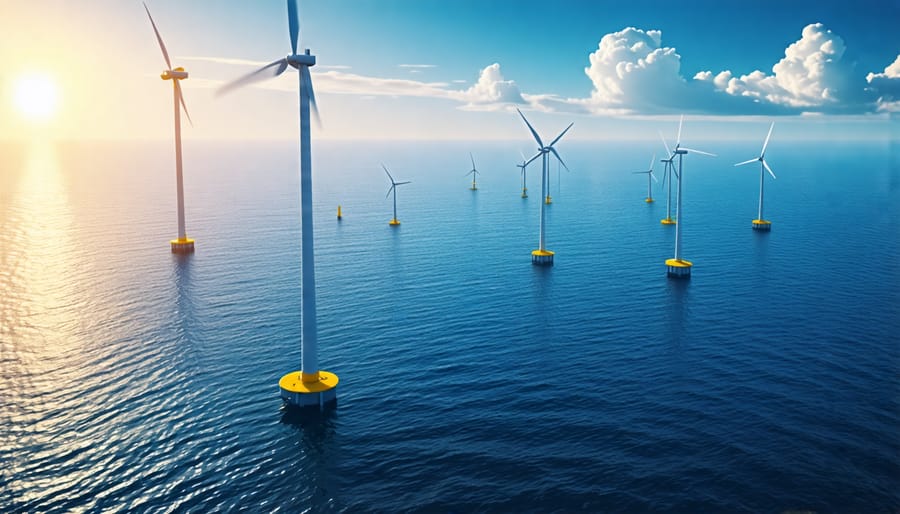
Advanced Turbine Designs
In recent years, advanced turbine designs have revolutionized the wind energy sector, boosting efficiency and energy output. One major breakthrough is in blade design. By employing aerodynamic principles akin to those used in aircraft wings, turbine blades are now streamlined to capture wind more effectively. This means more energy with less wind, enhancing the viability of turbines in areas not previously considered.
Materials have also seen significant innovation. Traditional blades were primarily crafted from fiberglass, but modern advancements incorporate carbon fiber and even lightweight composites. These materials increase strength while reducing weight, allowing turbines to have larger blades that can capture more wind energy without sacrificing structural integrity.
Organizations like Siemens Gamesa have been at the forefront of this movement. In an expert interview, a Siemens Gamesa engineer highlighted their novel blade technology, which uses recyclable resin. This opens pathways not just for stronger blades, but also for a circular economy, reducing waste. Similarly, the integration of digital technology with advanced design has resulted in smart turbines that optimize blade pitch and yaw angles in real-time, ensuring maximum efficiency.
From community projects in Denmark to large-scale operations off the U.S. coasts, these cutting-edge designs are paving the way for a cleaner, sustainable future, demonstrating the incredible potential of innovation in wind energy.
Integration of Wind Energy with Smart Grids
Smart Grid Technology
Smart grid technology plays a vital role in optimizing the management and distribution of wind energy, transforming how electricity networks function. By integrating advanced information and communication systems, smart grids can efficiently balance supply and demand, even as wind energy output fluctuates due to natural variations. One of the standout features is its ability to store excess energy generated during peak wind conditions, releasing it when demand is high or wind speeds are low. This dynamic capability ensures a stable and reliable power supply while maximizing the use of renewable sources.
These grids also facilitate real-time monitoring and control, allowing grid operators to swiftly respond to changes in energy output and consumption patterns. Such responsiveness is essential for maintaining grid stability and minimizing energy wastage. The integration of smart meters and sensors further enhances consumer engagement by providing detailed insights into energy usage, promoting more sustainable consumption behaviors.
Through case studies, we see countries like Denmark leading the way, where smart grids help optimize their significant wind energy contributions to the national grid. By harnessing the potential of smart grid technology, the global energy landscape can shift towards a more sustainable, resilient framework.
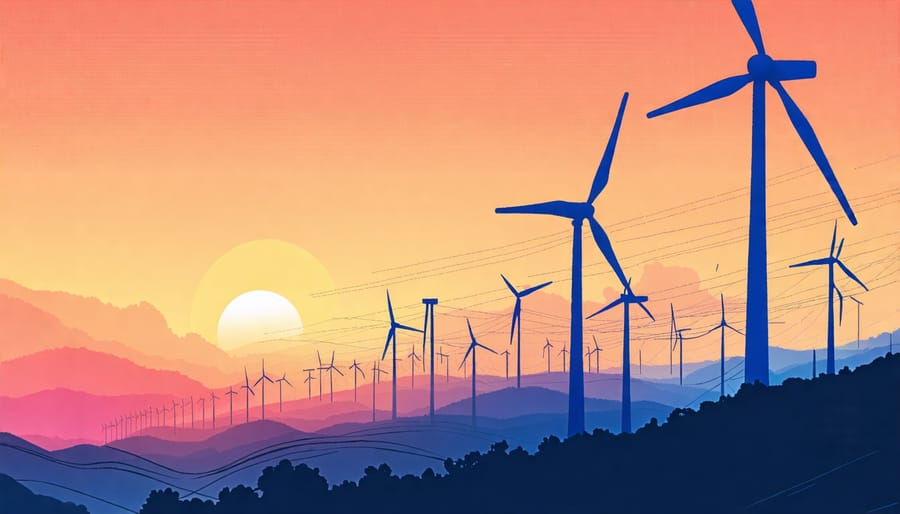
Real-Time Data and AI
Harnessing the power of wind energy has taken a leap forward with the integration of real-time data and artificial intelligence (AI), offering exciting advancements in efficiency and grid integration. By utilizing AI, wind farms can now dynamically adjust to changing weather patterns, optimizing power output and reducing operational costs. This is achieved through the seamless analysis of huge datasets, including wind speeds, turbine rotations, and grid demands, enabling predictive maintenance and efficient energy dispatch.
Real-life case studies illustrate AI’s transformative impact. For instance, in regions renowned for unpredictable wind patterns, AI algorithms can predict changes and automatically adjust turbine angles, ensuring maximum energy capture. Furthermore, AI-powered smart grids efficiently manage energy distribution, balancing supply and demand while minimizing losses. These innovations not only enhance the reliability of wind power but also support a sustainable transition to renewable energy, proving that data-driven solutions hold immense potential to revolutionize wind energy globally. Through these strides, we’re moving closer to a future powered by clean, uninterrupted energy.
Case Studies: Global Innovations
Europe’s Offshore Wind Expansion
Europe is making significant strides in offshore wind energy, positioning itself as a global leader in renewable energy innovation. The North Sea, once dominated by oil and gas rigs, is now bustling with offshore wind farms like Hornsea One and Borssele, demonstrating Europe’s commitment to sustainable energy. These projects highlight Europe’s investment in cutting-edge technology and environmental stewardship. Offshore wind energy harnesses powerful sea winds, resulting in higher energy output compared to onshore installations. With advancements in turbine design and materials, companies are building larger, more efficient turbines that can withstand harsh marine environments, representing a monumental shift towards cleaner energy solutions.
Not only is Europe reducing its carbon footprint, but it is also setting a global precedent, showing how international collaboration can drive sustainable energy development. Initiatives supported by European Union policies have streamlined funding and research, further accelerating growth in this sector. Countries worldwide look to Europe’s model as a blueprint for integrating wind energy into their energy portfolios. As Europe continues to innovate, it offers invaluable insights and a hopeful path forward for countries aiming to harness wind power and meet ambitious climate goals.
Community Wind Projects in the US
In the United States, community-driven wind energy projects are playing an increasingly vital role in promoting renewable energy adoption while delivering significant socio-economic benefits. These projects often involve local ownership, enabling communities to have a direct stake in their energy resources. This approach not only democratizes energy production but also fosters economic growth by generating local jobs, increasing tax revenues, and keeping energy dollars within the community.
One notable example is the Minwind Energy projects in Minnesota, a series of locally-owned wind farms that have become a model for sustainable community development. The profits generated by these wind projects are reinvested into local infrastructure, educational initiatives, and other community needs, ensuring that the benefits of renewable energy are directly felt.
Additionally, community wind projects offer more than just economic opportunities; they are an educational platform for renewable energy, increasing awareness and acceptance of sustainable practices. By involving local stakeholders, these projects build stronger, resilient communities dedicated to sustainable progress. Community wind energy projects thus embody the potential of renewable energy not just as an environmental solution, but as a catalyst for transformative community empowerment and engagement.
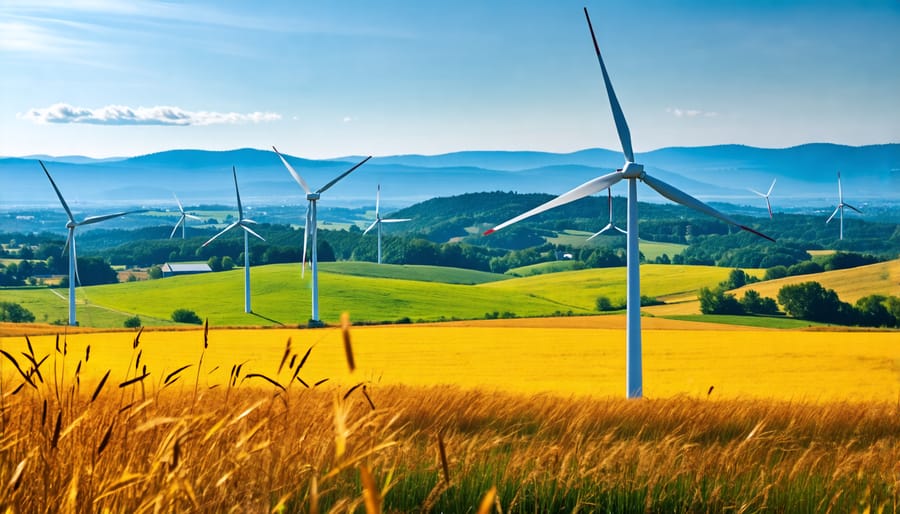
Future Trends and Challenges
Emerging Trends
As the wind energy sector evolves, several emerging trends are set to redefine its future. One key development is the advancement of offshore wind technology. With larger and more efficient turbines, offshore installations are now capable of harnessing stronger, steadier winds, significantly boosting electricity output. Floating wind farms, currently being tested, promise to expand wind energy potential by accessing previously unreachable deep-water sites.
On land, innovations in turbine design, like vertical-axis turbines, offer improved efficiency and lower wildlife impact. Enhanced materials and energy storage solutions also play a vital role in reducing costs and increasing the reliability of wind power, facilitating its integration into existing grids.
Furthermore, digital technologies are revolutionizing maintenance and operations through predictive analytics and remote monitoring systems, optimizing performance and lifespan of wind assets. Through these innovations, wind energy continues to make strides towards a sustainable energy future.
Overcoming Challenges
Wind energy innovation faces a triad of challenges that span regulatory, environmental, and technological domains. Regulatory hurdles often include complex permitting processes and inconsistent policies across regions, which can stall projects and dissuade investment. To navigate these, industry stakeholders advocate for streamlined policies that promote sustainable growth. Environmentally, wind turbine installations raise concerns about wildlife impacts and land use. Innovative design and strategic planning are essential to minimize these side effects while maximizing energy output. Technologically, integrating wind energy into aging grid infrastructures remains a challenge. Advances in smart grid technology and energy storage are crucial to enhance reliability and efficiency. Collectively, overcoming these barriers requires collaborative efforts among policymakers, environmentalists, and technologists, all driven by a shared vision for sustainable energy solutions.
Conclusion
In conclusion, wind energy stands at the forefront of the global shift towards sustainable energy solutions. Recent innovations in turbine technology, energy storage, and grid integration have significantly enhanced the efficiency and viability of wind power, reducing costs and expanding its reach. These advancements are vital in our collective effort to mitigate climate change and reduce reliance on fossil fuels. As policymakers, educators, and enthusiasts continue to champion these advancements, the future of renewable energy appears promising. This momentum in innovation not only fosters environmental sustainability but also drives economic growth and energy independence, underscoring the crucial role of wind energy in a greener future.

